Smallpox. Later, tuberculosis and diseases of the chest, then geriatric.
In 1894, during a smallpox epidemic which had begun the previous year, West Ham County Borough Council purchased the 116-acre Rookery Farm at Dagenham for £6,600 as a site for its smallpox hospital.
In October 1896 the Dagenham Parish Council objected to the plans for such a hospital, but it was too late - the foundation stone had been laid in August, some three months previously.
The Dagenham Smallpox Hospital opened on 25th March 1899. It consisted of single-storey brick buildings surrounding a quadrangle. The wards contained 16 beds each, and had windows 6 feet (2 metres) from the floor, so all the patients could see was the sky.
In 1911 the Local Government Board issued new regulations which made pulmonary tuberculosis (TB) a notifiable disease. In the same year, the National Insurance Act was passed, which compelled local authorities to establish TB hospitals. It came into operation in July 1912 and gave affected workers access to free treatment for the disease.
The West Ham County Borough Council considered their options regarding provision for the institutional treatment of their TB patients. One of their plans was to purchase a site at Langdon Hills, but this was considered too far from West Ham (in fact, on a clear day, Southend pier could be seen from it). It was decided that accommodation should be made available closer at hand, if only temporarily. (The Langdon Hills site was later used to build a Sanatorium for Children.)
On the advice of the Medical Officer of Health for the County, in 1912 the Dagenham Smallpox Hospital was converted into a TB sanatorium for 'Insured Persons under National Insurance'. It was renamed the Dagenham Sanatorium (but was also known as the West Ham Sanatorium).
A Resident Medical Officer was appointed, who commenced his duties in April 1914. By the end of the year, some 190 patients had been admitted to the Sanatorium.
During WW1 the Sanatorium was extended with the addition of wooden huts, each measuring 100 ft by 30 ft (31 metres by 9 metres) and containing 26-bedded wards in pairs, which shared a common annexe.
From April 1920 until the end of July 1922 the Sanatorium was closed to TB patients because the buildings had to be reserved for smallpox patients (although, after 1902, there had been no further epidemics of the disease).
The Dagenham Sanatorium reopened in 1922, and was permanently approved by the Ministry of Health as a 'hospital'.
In 1939, when it had 128 beds, it joined the Emergency Medical Service during WW2.
The Sanatorium joined the NHS in 1948 under the control of the Ilford and Barking Group Hospital Management Committee, part of the North East Metropolitan Regional Hospital Board. It consisted of two parts - the original brick buildings and the wooden huts from the WW1 era. All the buildings were single-storey, except for the Nurses' Home.
In 1951, when it had 133 beds, it was renamed Dagenham Hospital, but remained a specialist TB hospital.
A visit by assessors from the King's Fund noted the lack of facilities. In the wooden hutted wards 5 wash basins were shared by 52 patients, while in each of the brick wards 2 wash basins served 16 patients. One pair of hutted wards had no verandah, and no access to the garden except via a steep flight of 6 steps. The other pair of hutted wards did have a verandah, which faced south and onto which patients could be wheeled in their beds, but it was entirely open and could not be used in inclement weather.
Of the furthest pair of hutted wards, one was derelict and the other had been renovated and converted into a consulting room and a treatment room with a steriliser, as well as a Day Room for the patients, with the necessary ancillary rooms - 2 bathrooms and washrooms with 10 basins.
The Hospital covered a wide area, requiring a considerable road system. It did not have an operating theatre, but there was an X-ray Department, a dental surgery and an ENT casualty room, a Pathology Laboratory, a dispensary and a cramped kitchen.
In 1952 the Hospital had 137 beds and, in 1953, 129. In 1954 there were 155 beds with the average length of stay for in-patients being one year.
By 1957 the average age of the patients on admission had increased, and this more elderly group required more nursing care.
At the end of the 1950s the roads on the site were improved. The furniture and equipment on the wards were renewed and the Pathology Laboratory redecorated and re-equipped. The X-ray Department was rehoused and new accommodation was built for the resident medical staff.
In 1959 the Hospital had 145 beds for patients with TB and other chest diseases. The demand for TB beds remained high (during 1959 some 206 patients were admitted). The average length of stay was 213 days. In 1960 there were 201 admissions for TB, but the extensive use of chemotherapy enabled a marked reduction in stay - 160 days on average.
The derelict hut, which had housed the patients' Concert Hall, cinema and chapel, was finally considered unsafe and had to be pulled down. The other hut nearby, used mainly as a Day Room and billiards room, was altered to fulfill all the functions.
In January 1960, when the Hospital had 150 beds, a 14-bedded ward was converted for use by non-TB cases and, in June, 20 geriatric female patients from Chadwell Heath Hospital, which was undergoing alterations, were temporarily accommodated there.
In 1962 the Hospital had 145 beds and, in 1965, 121 beds for patients with diseases of the chest.
By 1970 it had 56 beds for male patients with chest disease and 59 beds for geriatric patients.
Following a major reorganisation of the NHS in 1974, the Hospital came under the control of the Redbridge and Waltham Forest Area Health Authority, part of the North East Thames Regional Health Authority. It still had 56 beds for males with chest disease, but the bed complement for geriatric patients had increased to 137.
In 1980 it had become a geriatric hospital with 128 beds for long stay patients.
The Hospital closed in 1989.
Present status (June 2008)
The Hospital buildings were demolished but the site became derelict before being transformed, in 2006, into an extension of the Beam Valley Country Park.
Many of the original trees remain. The Hospital site is reputed to be haunted.
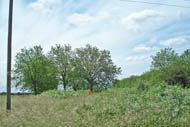
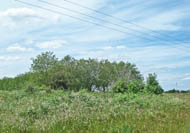
The site from the north. It is now mostly overgrown by weeds and brush

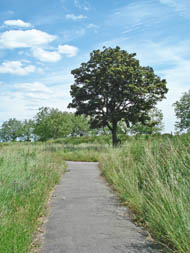
A mature tree on the west side of the site (left) and one in the centre of the site (right).
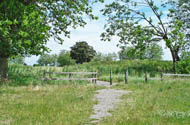
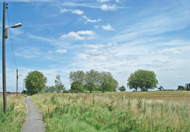
The entrance path and the site from the south.
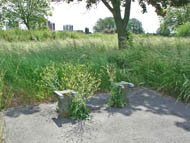
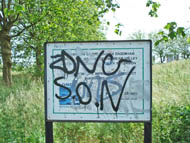
A park amenity - a former bench (left) and a sign board crediting the site of the Hospital, with added graffiti (right). The parkland is not too badly vandalized if one ignores the burnt-out motorbikes on the path.
Ashworth Underwood E 1961 Obituary. G.M. Mayberry. British Medical Journal 1 (5266), 1576.
http://essexparanormal.proboards.com
https://boroughphotos.org
www.barking-dagenham.gov.uk
www.basildon.com
www.british-history.ac.uk
Return to home page